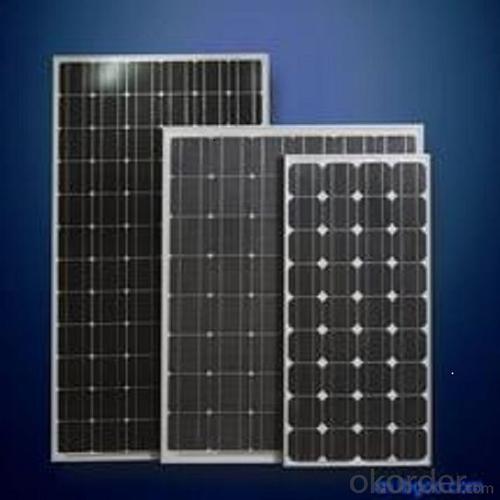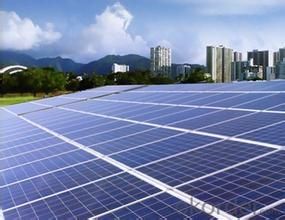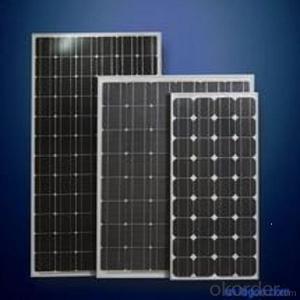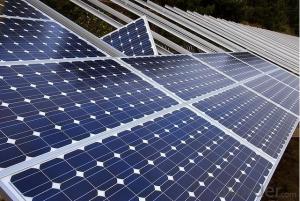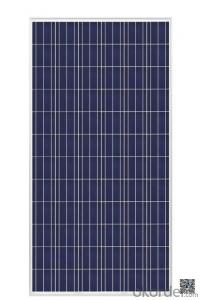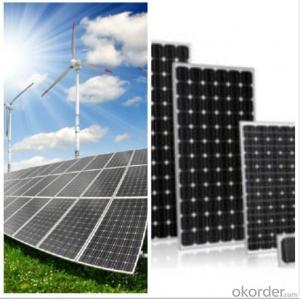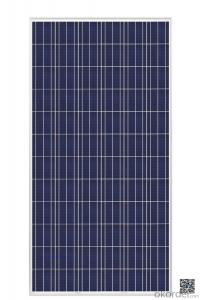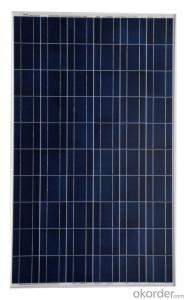Roof for Solar Panels:250W Solar Module Panel with Full Certificate
- Loading Port:
- Shanghai
- Payment Terms:
- TT OR LC
- Min Order Qty:
- 2600 watt
- Supply Capability:
- 26000 watt/month
OKorder Service Pledge
OKorder Financial Service
You Might Also Like
Specification
Product Description:
1.Structure of Solar Module Description
Solar panel refers either to a solar hot water panel, a common type of a solar thermal collector, or to one or more solar photovoltaics (PV) modules, electrically connected and mounted on a supporting structure.
A PV module is a packaged, connected assembly of typically 6×10 solar cells. Solar PV panels constitute the solar array of a photovoltaic systemthat generates and supplies solar electricity in commercial and residential applications. Each module is rated by its DC output power under standard test conditions, and typically ranges from 100 to 320 watts. The efficiency of a module determines the area of a module given the same rated output – an 8% efficient 230 watt module will have twice the area of a 16% efficient 230 watt module. There are a few solar panels available that are exceeding 19% efficiency. A single solar module can produce only a limited amount of power; most installations contain multiple modules. A photovoltaic system typically includes a panel or an array of solar modules, an inverter, and sometimes a battery and/or solar tracker and interconnection wiring.
2.Main Features of the Solar Module
1).High conversion efficiencies resulting in superior power output performance.
2).Outstanding power output even in low light or high temperature conditions
3).Optimized design for ease of soldering and lamination
4).Long-term stability,reliability and performance
GENERAL INFORMATION
The installation of PV modules requires a great degree of skill and should only be performed by a qualified licensed professional, including licensed contractors and licensed electricians. Please be aware that there is a serious risk of various types of injury occurring during the installation including the risk of electric shock. All CUSTOMER modules are equipped with a permanently attached junction terminal box that will accept variety of wiring applications or with a special cable assembly for ease of installation, and they do not require assembly.
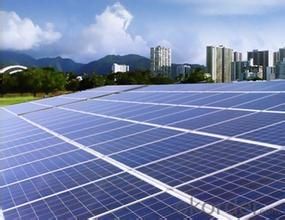
GENERAL SAFETY
1. Consult local codes and other applicable laws concerning required permits on regulations concerning installation and inspection requirements.
2. Before installation a PV module, contact appropriate authorities to determine permit, installation and inspection requirements that should be followed.
3. Install PV modules and ground frames in accordance with applicable rules and regulations
4. PV modules should be installed and maintained by qualified personnel. Only installer/service personnel should have access to the PV module installation site.
5. No matter where the PV modules are installed, either roof mounted construction or any other type of structures above the ground, appropriate safety practices should be followed and required safety equipment should be used in order to avoid possible safety hazards. Note that the installation of some PV modules on roofs may require the addition of fireproofing, depending on local building / fire codes.
6. Please use PV modules with same cell size within series.
7. Follow all safety precautions of other components used in the system.
8. In order to avoid a risk of injury or electrical shock, do not allow anyone to approach the PV module if the person has little knowledge on PV module or on the measures that should be taken when PV modules are damaged.
9. Do not clean the glass surface with chemicals. Do not let water stay on the glass surface of PV modules for a long time. This creates a risk of white efflorescence(glass disease) which may result in the deterioration of energy generation.
10. Do not clean the glass surface with chemicals. Do not let water stay on the glass surface of PV modules for a long time. This creates a risk of white efflorescence ( glass disease ) which may result in the deterioration of energy generation.
11. Do not install the PV module horizontally. It may cause dirt or white efflorescence (glass disease) due to water.
12. Do not cover the water drain holes of the frame. There is a risk of frost damage when the frame is filled with water copulation.
13. When sliding snow load has to be considered, an appropriate measure has to be taken so that PV module frames on lower edge of PV modules will not be damaged.
14. Do not expose PV module to sunlight concentrated with mirrors, lenses or similar means.
15. Turn off inverters and circuit breakers immediately, should a problem occur.
16. In case the glass surface of a PV module is broken, wear goggles and tape the glass to keep the broken pieces in place.
17. A defective PV module may generate power ever if it is removed from the system. It may be dangerous to handle the PV module while exposed to sunlight. Place a defective PV module in a carton so PV cells are completely shaded.
18. In case of series connection , the maximum open circuit voltage must not be greater than the specified maximum system voltage. The voltage is proportional to the number of series. In case of parallel connection, please be sure to take proper measure to block the reverse current flow. The current may easily flow in a reverse direction.
- Q: how efficient are flexible solar panels?
- One I got about 3 years ago is about 50% as efficient as a glass panel I got about 0 years ago. Not exactly a scientific study, I know.
- Q: I had someone quote me for solar panels on my house but I can't afford it. They were talking about how I have enough room and the perfect location to put many of them and actually get paid for it. I have about a half acre that is tiered and points in the correct direction for them to get pretty much the full day sun. Additionally, I live in so cal where it is sunny most of the year. Does anyone know if solar companies will lease or install them to get the payback? I would be happy to allow them to use the land just to cover my electrical expense and they could have any payback.
- There okorder /... The article below gives some other creative ways to finance a PV system.
- Q: Can solar panels be used in areas with high pollution?
- Yes, solar panels can be used in areas with high pollution. While pollution can reduce the efficiency of solar panels to some extent by blocking sunlight, they can still generate electricity. However, regular maintenance and cleaning of the panels may be required to ensure optimal performance. Additionally, the use of advanced technologies and designs can help mitigate the effects of pollution on solar panel efficiency.
- Q: Do solar panels require a specific type of mounting system for installation?
- Yes, solar panels typically require a specific type of mounting system for installation. The mounting system is designed to securely hold the solar panels in place and ensure optimal positioning for maximum sunlight exposure. There are various types of mounting systems available, including roof mounts, ground mounts, and pole mounts, each suited for different installation scenarios.
- Q: Can solar panels be used to power a train?
- Yes, solar panels can be used to power a train. Solar panels generate electricity by converting sunlight into energy, which can be used to power various systems, including trains. However, the feasibility and efficiency of using solar panels to power a train will depend on several factors such as the size of the train, the available surface area for solar panel installation, the train's energy requirements, and the geographical location's solar potential.
- Q: i have a 50 watt 2 Volt solar panel..Will it can switch on directly a car head light on a sunny day??? How much head lights it can support on a bright sunny day??? if its cloudy then can it run a single Head light???? i have no batteries just want to connect a car Head light directly to solar panel.
- Indestructible okorder /
- Q: How do solar panels generate electricity?
- Solar panels generate electricity through the photovoltaic effect. When sunlight hits the solar cells within the panels, the photons from the sunlight excite the electrons in the cells, causing them to move and create an electric current. This current is then captured and converted into usable electricity for various applications.
- Q: Has anyone had any experience building their own solar panels for home use? I have seen on the news lately that people are utilizing solar panels to power their hot water heaters to save on their power bill.
- a solar hot water heater is not a solar panel that makes electricity that runs your hot water heater.....it is merely a long tube or pipe, bent back on itself so there,s, say 00 feet in a 2foot by 4 foot space; it's in a framework and under a sheet of glass or plastic; You put out in the sun and it captures heat.....ever notice how hot the water is coming out a garden hose that has been left out in the sun in summer? Same idea.. we have used them here in the islands for years and they work great. Even up north, a solar hot water heater that preheats the water before it goes to a traditional water heater should work fine.
- Q: DIY, buying solar panels, room is barely 200 sq. ft. have a 5000 btu air conditioner, how many watts do I need, thinking of buying 75 watt solar panels, have space on the roof.
- Yes you can.. Use it to charge a 2 volt battery then use the battery power to run a 2 volt halogen bulb. Would be much better to power some LED's with the battery -- just as much light but will last longer.
- Q: I just connected my 5 Watt 2V solar panel directly to my 300 Watt 2 inverter. It worked for about 2 minutes then it popped (sparks, smoke etc)! What the hell did I do wrong? I thought the solar panel was 2 volts? Can someone with experience with these things help me out?
- An 300W inverter will draw 25 amps from a car battery but the solar panel will only produce about 4 amps. By drawing too much power with the inverter you lowered the voltage so much in the panels wiring that the amp rating on the internal wiring was exceeded and they melted. Next, time run the panel to a voltage regulator, then the regulator to a car battery, then the battery to the inverter.
Send your message to us
Roof for Solar Panels:250W Solar Module Panel with Full Certificate
- Loading Port:
- Shanghai
- Payment Terms:
- TT OR LC
- Min Order Qty:
- 2600 watt
- Supply Capability:
- 26000 watt/month
OKorder Service Pledge
OKorder Financial Service
Similar products
Hot products
Hot Searches
Related keywords


